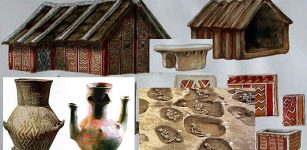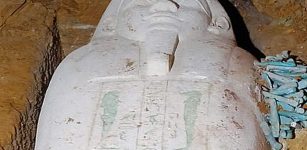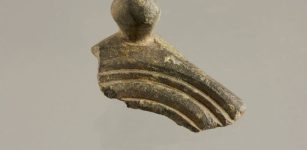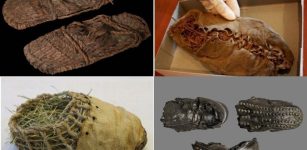Unsolved Mystery Of The Giant Footprints Outside The Ain Dara Temple
Ellen Lloyd - AncientPages.com - Outside the Ain Dara temple's entrance is a pair of giant footprints. It remains unknown who made them and why they were carved.
Our ancestors' conviction that superhuman beings gigantic in size once roamed the Earth is repeatedly reflected in ancient myths and legends.
Ain Dara, located northwest of Aleppo, Syria, an Iron Age Syro-Hittite temple. Image credit: Institute for the Study of the Ancient World Contact - CC BY 2.0
The once magnificent Ain Dara temple, or what's left, first attracted attention in 1955 when a monumental basalt lion was accidentally discovered.
If we travel to the village of Ain Dara, northwest of Aleppo, Syria, we come across an Iron-Age temple. The temple was later excavated between 1980 and 1985 and has often been compared to King Solomon's Temple.
As the Bible History Daily states, "the similarities between the 'Ain Dara temple and the temple described in the Bible are striking. Both buildings were erected on massive artificial platforms at the highest point in their respective cities.
The buildings likewise have similar tripartite plans: an entry porch supported by two columns, the main sanctuary hall (the hall of the 'Ain Dara temple is divided between an antechamber and the main chamber), and then, behind a partition, an elevated shrine, or Holy of Holies.
Colossal basalt lion found in 1955. (Ain Dara, Syria). Image credit: Materialscientist - CC BY 2.0
They were also both flanked on three of their sides by a series of multistoried rooms and chambers that served various functions."
However, although the Ain Dara temple shares many features with King Solomon's temple, it's unlikely it was the same building.
According to the excavator, Ali Abu Assaf, the Ain Dara temple existed for 550 years, from about 1300 BC. to 740 BC.
Archaeologists still cannot agree on the deity to whom the temple was dedicated. Some believe that it was dedicated to Ishtar, the goddess of fertility. Others suggest that it was the goddess Astarte, owner of the sanctuary. Yet, another group means it is likely that the temple holder was the god Baal Hadad.
The Ain Dara temple has several beautifully preserved structural features, including limestone foundations and blocks of basalt.
Reconstructed wall of Ain Dara Temple with cherubim relief in lower panel. Image credit: Odilia - CC BY-SA 3.0
Originally the building also had mudbrick covered with wood paneling, but today it's unfortunately lost.
The facade and interior walls are enlivened by hundreds of finely carved reliefs depicting lions, cherubim, mythical creatures, mountain gods, palmettes, and ornate geometric designs.
A pair of carved giant footprints are at the threshold of the entrance of the Ain Dara temple. They are about one meter long and face toward the temple's interior.
Like Solomon's Temple, the 'Ain Dara temple was approached by a courtyard paved with flagstones. The left footprint was carved on the flagstone, indicating that the god was entering the temple. The right impression was carved at the threshold to the cella, telling that the giant god needed only two steps to enter the temple.
Giant footprints outside the Ain Dara Temple. Credit: Verity Cridland - CC BY 2.0
The distance between the two single footprints is about 30 feet.
A stride of 30 feet would belong to a person (or goddess) about 65 feet tall. The temple is large enough for the god to enter and dwell in.
However, they were unlikely left by a being that entered the temple. The giant footprints remain an unsolved puzzle.
Scholars do not know why they were carved and what purpose they served. Some scientists have suggested that footprints can be designed to recall the presence of the gods, a sort of iconic representation of the deity. Although this is not a genuine pair of giant footprints, the carving is real, and it suggests our ancestors were familiar with and witnessed beings of gigantic size. Another possibility is that the huge footprints have a symbolic meaning.
Written by - Ellen Lloyd – AncientPages.com
Updated on April 2, 2023
Copyright © AncientPages.com All rights reserved. This material may not be published, broadcast, rewritten or redistributed in whole or part without the express written permission of AncientPages.com
More From Ancient Pages
-
 Controversial Artifact Fuente Magna Could Re-Write Ancient History – America’s Mysterious Rosetta Stone
Artifacts | Oct 18, 2014
Controversial Artifact Fuente Magna Could Re-Write Ancient History – America’s Mysterious Rosetta Stone
Artifacts | Oct 18, 2014 -
 Controversial Discovery : 15,000 Ancient Ebla Tablets Prove Old Testament To Be Accurate
Archaeology | Oct 5, 2015
Controversial Discovery : 15,000 Ancient Ebla Tablets Prove Old Testament To Be Accurate
Archaeology | Oct 5, 2015 -
 Lengyel Culture Of Neolithic Europe Was Amazingly Sophisticated
Civilizations | Apr 7, 2020
Lengyel Culture Of Neolithic Europe Was Amazingly Sophisticated
Civilizations | Apr 7, 2020 -
 Limestone Sarcophagus, Ushabti Figures Unearthed In Minya’s Al-Gharafa Area, Egypt
Archaeology | Oct 3, 2020
Limestone Sarcophagus, Ushabti Figures Unearthed In Minya’s Al-Gharafa Area, Egypt
Archaeology | Oct 3, 2020 -
 Ancient Mystery Of Leti – A Homo Naledi Child Of Darkness Discovered In The Rising Star Cave System
Archaeology | Nov 6, 2021
Ancient Mystery Of Leti – A Homo Naledi Child Of Darkness Discovered In The Rising Star Cave System
Archaeology | Nov 6, 2021 -
 Piece Of Puzzling Roman Artifact Discovered In Belgium
Archaeology | Feb 16, 2023
Piece Of Puzzling Roman Artifact Discovered In Belgium
Archaeology | Feb 16, 2023 -
 Stone Age Settlement Discovered Underwater In Finland
Archaeology | Aug 9, 2018
Stone Age Settlement Discovered Underwater In Finland
Archaeology | Aug 9, 2018 -
 Unearthing Vadnagar And The Search For Hueng Tsang’s 10 Monasteries
Archaeology | Dec 11, 2015
Unearthing Vadnagar And The Search For Hueng Tsang’s 10 Monasteries
Archaeology | Dec 11, 2015 -
 Maya Town Hunacti In Northern Yucatán Stood Defiantly In Early Colonial Era
Archaeology | Sep 2, 2025
Maya Town Hunacti In Northern Yucatán Stood Defiantly In Early Colonial Era
Archaeology | Sep 2, 2025 -
 25 Stone Age Caves And Rock Carvings Found In Odisha, India
Archaeology | Mar 30, 2017
25 Stone Age Caves And Rock Carvings Found In Odisha, India
Archaeology | Mar 30, 2017 -
 Probably The Oldest Star Map Discovered In Stone Chamber Of The Kitora Tomb, Asuka Nara, Japan
Ancient History Facts | Jul 19, 2015
Probably The Oldest Star Map Discovered In Stone Chamber Of The Kitora Tomb, Asuka Nara, Japan
Ancient History Facts | Jul 19, 2015 -
 Arsinoe II Rose To Power Through Manipulations, Murder, Conspiracies And Became Worshiped As A Goddess
Featured Stories | Apr 26, 2019
Arsinoe II Rose To Power Through Manipulations, Murder, Conspiracies And Became Worshiped As A Goddess
Featured Stories | Apr 26, 2019 -
 Zuni Indians Bravely Fought For Their Ancient Culture, Traditions And Respect For Their Ancestors
Featured Stories | Mar 14, 2018
Zuni Indians Bravely Fought For Their Ancient Culture, Traditions And Respect For Their Ancestors
Featured Stories | Mar 14, 2018 -
 World’s Oldest Shoes: Some Look Surprisingly Modern
Artifacts | Jun 22, 2023
World’s Oldest Shoes: Some Look Surprisingly Modern
Artifacts | Jun 22, 2023 -
 Giant Bath Tub Built For Tsar Alexander I – Why Was It So Large?
Featured Stories | Jul 11, 2018
Giant Bath Tub Built For Tsar Alexander I – Why Was It So Large?
Featured Stories | Jul 11, 2018 -
 On This Day In History: Henry II Crowned King Of England – On Dec 19, 1154
News | Dec 19, 2016
On This Day In History: Henry II Crowned King Of England – On Dec 19, 1154
News | Dec 19, 2016 -
 Ancestral Home Of All Humans Revealed Through World’s Largest Genome Reconstruction Of Our Ancestors
Archaeology | Jan 3, 2023
Ancestral Home Of All Humans Revealed Through World’s Largest Genome Reconstruction Of Our Ancestors
Archaeology | Jan 3, 2023 -
 Ancient Oil Lamp Shop Discovered In Aizanoi, The Second Ephesus
Archaeology | Nov 22, 2021
Ancient Oil Lamp Shop Discovered In Aizanoi, The Second Ephesus
Archaeology | Nov 22, 2021 -
 Anchor Church Caves – Has The Home Of Anglo-Saxon King Eardwulf And Saint Hardulph Been Found?
Archaeology | Jul 23, 2021
Anchor Church Caves – Has The Home Of Anglo-Saxon King Eardwulf And Saint Hardulph Been Found?
Archaeology | Jul 23, 2021 -
 Ancient Egyptian Papyrus Tells A Different Story About Biblical Isaac’s Fate
Archaeology | May 1, 2018
Ancient Egyptian Papyrus Tells A Different Story About Biblical Isaac’s Fate
Archaeology | May 1, 2018




